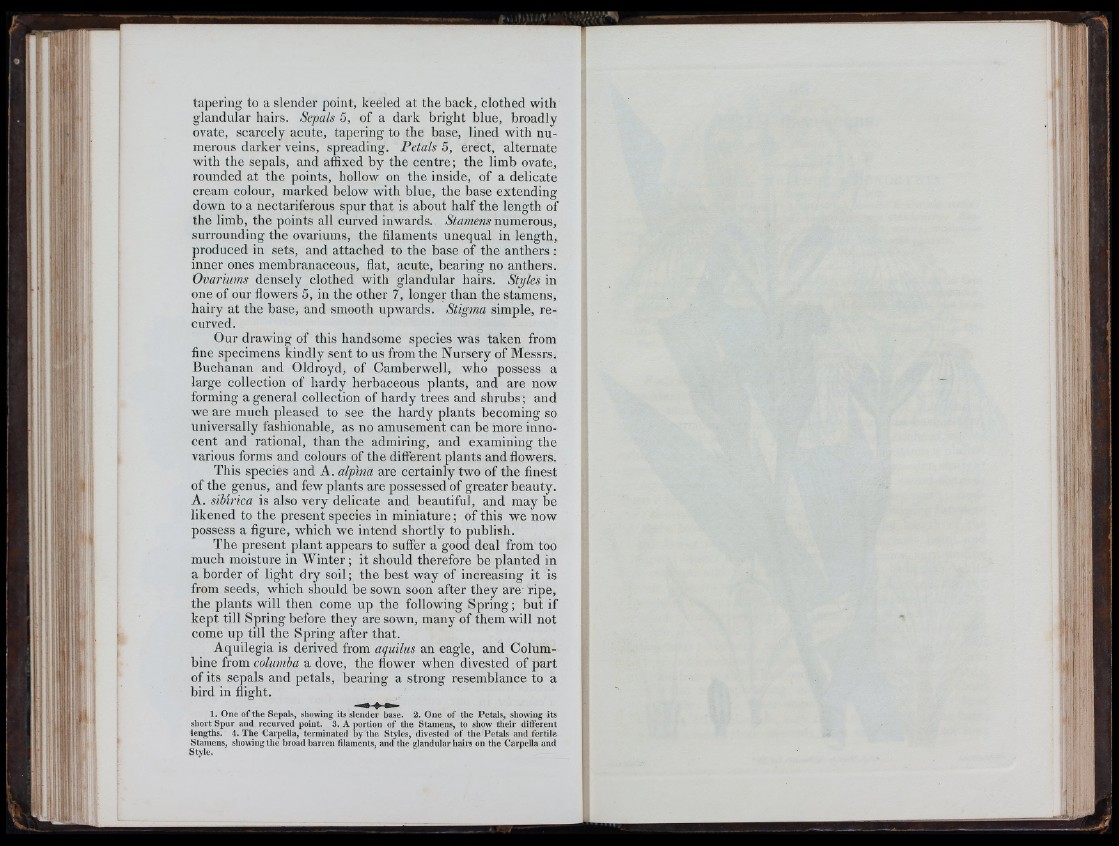
: •
'Lih
; 1 1
*1
' li"
i
;r
'I I
Ik I■'■I,:
tapering to a slender point, keeled at the back, clothed with
glandular hairs. Sepals 5, of a dark bright blue, broadly
ovate, scarcely acute, tapering to the base, lined with numerous
darker veins, spreading. Petals 5, erect, alternate
with the sepals, and affixed by the centre; the limb ovate,
rounded at the points, hollow on the inside, of a delicate
cream colour, marked below with blue, the base extending
down to a nectariferous spur that is about half the length of
the limb, the points all curved inwards. Stamens numerous,
surrounding the ovariums, the filaments unequal in length,
produced in sets, and attached to the base of the anthers :
inner ones membranaceous, flat, acute, bearing no anthers.
Ovariums densely clothed with glandular hairs. Styles in
one of our flowers 5, in the other 7, longer than the stamens,
hairy at the base, and smooth upwards. Stigma simple, recurved.
Our drawing of this handsome species was taken from
fine specimens kindly sent to us from the Nursery of Messrs.
Buchanan and Oldroyd, of Camberwell, who possess a
large collection of hardy herbaceous plants, and are now
forming a general collection of hardy trees and shrubs; and
we are much pleased to see the hardy plants becoming so
universally fashionable, as no amusement can be more innocent
and rational, than the admiring, and examining the
various forms and colours of the different plants and flowers.
This species and A. alpina are certainly two of the finest
of the genus, and few plants are possessed of greater beauty.
A. sibirica is also very delicate and beautiful, and may be
likened to the present species in miniature; of this we now
possess a figure, which we intend shortly to publish.
The present plant appears to suffer a good deal from too
much moisture in Winter; it should therefore be planted in
a border of light dry soil; the best way of increasing it is
from seeds, which should be sown soon after they are ripe,
the plants will then come up the following Spring; but if
kept till Spring before they are sown, many of them will not
come up till the Spring after that.
Aquilegia is derived from aquilus an eagle, and Columbine
from columba a dove, the flower when divested of part
of its sepals and petals, bearing a strong resemblance to a
bird in flight.
1. One of the Sepals, showing its slender base. 2. One of the Petals, showing its
sliort Spur and recurved point. 3. A portion of the Stamens, to show their different
lengths. 4. The Carpella, terminated by the Styles, divested of the Petals and fertile
Stamens, showing the broad barren iilaments, and the glandular hairs on the Carpella and
Style.
'A
i' ' \ \\
i f
' i,
, 'I-.
.U,v